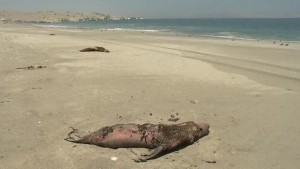
ANTOFAGASTA, Chile (Reuters) — Dozens of sea lions have washed up on Chile’s northern shore in the region of Antofagasta, local media reported on Thursday (February 25).
It was a grim scene on the beach of the coastal town of Hornitos, with most of them found in an advanced state of decomposition.
Chilean environmental authorities have said the animals are dying of starvation because the El Nino phenomenon is causing a scarcity of phytoplankton. Phytoplankton is needed to feed anchovy and sardine– both of which are an essential part of sea lions’ diet.
Carlos Guerra, a biologist from the University of Antofagasta, said dead sea lions have been found along the whole coast of Antofagasta. Others have left the area in search for food.
“Sea lions have died practically in all breeding grounds throughout our region we have inspected. There is an absence of sea lions in the rocks where thousands of these animals are usually found. There is an absence. That means these animals have travelled far, very far away, probably looking for places to scrounge for food,” Guerra said.
The situation is worrying, since experts do not know how long this phenomenon will last. Bodies started washing up on shore two months ago, local media reported.
For the time being, sea lions found alive – especially babies – are rescued by officials from the National Fisheries Service, Sernapesca, and taken to a rescue centre at the University of Antofagasta to care for them and subsequently return them to the wild.
“In a series of calls, we detected newborn sea lions, which are on the coast, so the procedure in the face of these events, is to go to their rescue and refer them to the rescue centre at the University of Antofagasta,” said Sernapesca director, Carlos Herrera.
The South American sea lion is found along the coast and offshore islands of South America. The endpoints of its range are Zorritos in northern Peru and Ilha dos Lobos in southern Brazil. Notable breeding colonies include Lobos Island, Uruguay; Peninsula Valdes, Argentina and the Falkland Islands.







